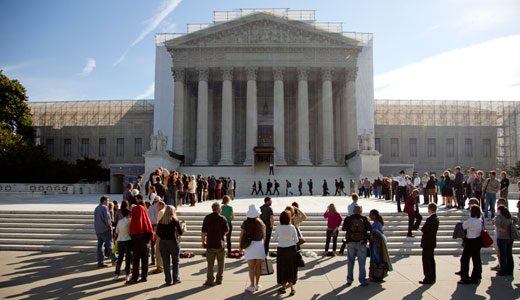
The U.S. Supreme Court ruled in a 7-to-1 decision today to send an affirmative action case back to a lower court for reconsideration. Fisher v. the University of Texas was a challenge to that school’s affirmative action policy by a white student, Abigail Fisher, whose application for admission as an undergraduate was turned down.
The Fifth Circuit Court of Appeals, as well as a lower district court, both had upheld the university’s policy.
In its ruling today the Supreme Court endorsed previous decisions establishing affirmative action as constitutional. That aspect is being hailed as a major victory. But the ruling also vacated the lower court’s decision to uphold the university’s policy, saying the appeals court did not apply “strict scrutiny” to the policy.
“The Fifth Circuit must assess whether the University has offered sufficient evidence to prove that its admissions program is narrowly tailored to obtain the educational benefits of diversity,” according to the written opinion issued by the court. In other words, the Supreme Court ruling appeared to tighten the criteria for acceptable affirmative action programs.
The University of Texas affirmative action policy was possible as a result of the court’s last major ruling on affirmative action – a 2003 case out of the University of Michigan, Grutter vs. Bollinger.
In Grutter, the Supreme Court reaffirmed that universities could use race as one of many admissions factors when selecting incoming students.
The University of Texas, as per state law, offers admission to the top eight percent of Texas high school students. For students who don’t qualify for this automatic admission, race is used to help achieve a diverse student body.
More than eight in 10 African American and Latino students who enrolled at the main campus in 2011 were automatically admitted under the state law that requires the university to offer admission to the top eight percent of Texas high school students.
Wade Henderson, president and CEO of the Leadership Conference on Civil and Human Rights, described the Supreme Court’s ruling as “an important victory for our nation’s ongoing work to build a more inclusive, diverse America.” He described the University of Texas’s admissions policy as “carefully crafted” and he predicted that it will ultimately be upheld by the appeals court.
“In reaffirming that a diverse learning environment benefits students, our workforce, and the country as a whole,” Wade said, “the ruling makes it clear that now is the time to expand our commitment to diversity in all of our institutions to ensure that we are well positioned to compete in the diverse economy of the 21st century.”
Sherrilyn Iffil, president and director-counsel of the NAACP’s Legal Defense Fund, ageed that the Supreme Court “has made a full-throated defense of preceding cases that uphold the essential nature of diversity in our nation’s institutions.”
“We should remember though,” said Iffil, “that affirmative action is just one of a number of tools we need to use to achieve diversity. Economic fairness and opportunity for poor people are just two examples of many other things we need to see.”
It was the NAACP’s Legal Defense Fund that took the Brown v. Board of Ed case before the U.S. Supreme Court in 1954, resulting in the historic decision that struck down “separate but equal” Jim Crow schools across the South.
More than 80 organizations – labor, religious and community groups among them – filed briefs urging the Supreme Court to uphold the Texas affirmative action plan. Among them was the American Civil Liberties Union.
“Today’s near-unanimous decision leaves intact the important principle that universities have a compelling interest in a diverse student body, and that race can be one factor among many that universities consider in a carefully crafted admissions program,” said Dennis Parker, director of the ACLU’s Racial Justice program. “We believe that the University of Texas has made a strong showing that its admission plan was necessary to achieve meaningful diversity, and that it can and should be upheld under the standard that the Supreme Court announced today.”
The one dissenter to the Court’s ruling, Justice Ruth Bader Ginsburg, said that the appeals court had acted correctly in the first place. “I would not return this case for a second look,” she wrote in her dissent, because “the University reached the reasonable, good-faith judgment that supposedly race-neutral initiatives were insufficient to achieve, in appropriate measure, the educational benefits of student body diversity.”
Photo: The U.S. Supreme Court (pictured) ruled in a 7-to-1 decision today to send an affirmative action case back to a lower court for reconsideration. AP










